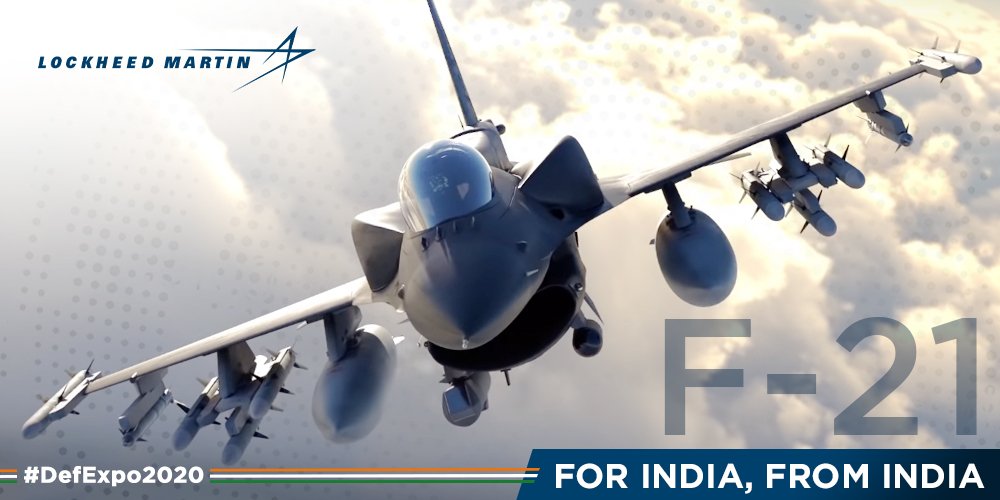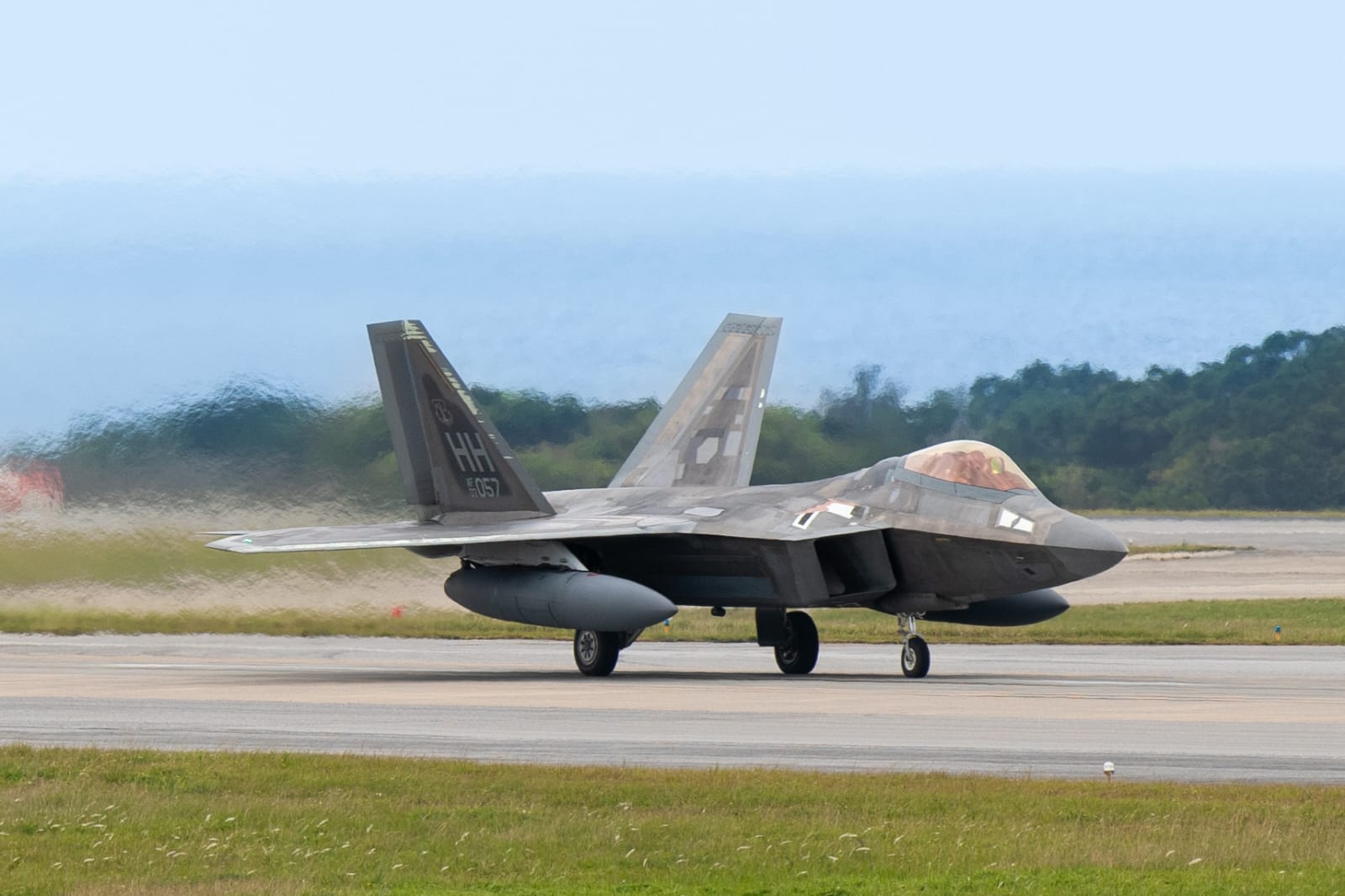The Lockheed Martin’s F-21 is a fighter jet specifically configured for India. It is the American contender in the 114 Medium Role Fighter Aircraft (MRFA) deal for the Indian Air Force (IAF).
The F-21 is not just a redesignated F-16, but it packs more punch than the F-16 Block-70 combat jets and has been touted as just one step behind the 5th generation stealth fighter F-22 ‘Raptor.’
The EurAsian Times juxtaposed the features of the two aircraft together for a better picture of the capabilities of the F-21 and F-22.
The sales pitch that American aircraft maker Lockheed Martin has made for F-21 is “For India, From India.”
Should Lockheed Martin bag the deal, it will shift the manufacturing line for F-21 in India. It has already partnered with the Indian firm Tata Group and created Tata Lockheed Martin Aerostructures Limited. The facility in India would manufacture the aircraft in India and components for the F-16 global supply chain.
Some forward movement is expected on the MRFA deal after the national elections conclude in India and a new government takes charge in New Delhi. Despite giving a big order for indigenous Light Combat Aircraft (LCA) Mk1A, the IAF has sent a proposal to acquire 114 fighter jets with a caveat for ‘Make in India.’

The proposal has yet to get an acceptance of necessity from the government, as the timelines for developing LCA Mk2 and the MRFA deal will be running concurrently.
Former Vice Chief of IAF Air Marshal Anil Khosla had told the EurAsian Times that while the indigenous Tejas are easy to make, “there is a requirement for new-generation multi-role aircraft to maintain a balanced force (until the domestic Tejas Mk II and Advanced Medium Combat Aircraft is ready).”
On the face of it, the F-21 design looks similar to the F-16 Block 70 combat jet, but it also draws from the DNA of the F-22 Raptors and F-35 Lightning II as well. Roughly half of the F-21 and F-16 supply chains are common with that of the two-5th generation American fighters.
The features that set the F-21 apart from the F-22 are its airframe, weapons capability, engine matrix, and availability of engine operations. The F-21 jets have been described as the most advanced F-16 variant ever built, incorporating futuristic avionics from the F-35 Lightning II and the F-22 Raptor.
The F-21 is a variant of the F-16 Block 70, and its IAF-specific features were also unveiled at Aero-India 2023. The sales pitch included an advanced APG-83 Active Electronically Scanned Array (AESA) radar, which has detection ranges nearly double those of previous mechanically scanned array radars and the ability to track and attack more targets with higher precision.
Besides, the F-21 will have Triple Missile Launcher Adapters (TMLAs) that allow it to carry 40 percent more air-to-air weapons than previous F-16 designs.
In a video released by Lockheed Martin in 2019, the new variant appears to sport ten missiles- eight medium-range, radar-guided AMRAAM missiles in addition to two AIM-9x Sidewinders. The fighter also featured an aerial refueling probe and a Snipe electro-optical targeting pod.
Lockheed illustrations show the plane with a heavy weapons load and a Sniper targeting pod. The cockpit’s instrument panel has a large, single screen, similar to the company’s F-35 Joint Strike Fighter.
The F-21 is an advanced, single-engine, multi-role fighter with the most optimal life-cycle cost for the IAF and the longest service life among all competitors: 12,000 flight hours. The F-21 is also the only fighter in the world capable of both probe/drogue (the most widely used in the world) and boom (USAF standard) aerial fuelling capability.
The probe-and-drogue refueling equipment is simple, light, and easy to install. A hose-drogue pod can be added to any aircraft with enough payload capacity, including fighters, large transport aircraft, and UAVs. This and a conformal fuel tank will provide the IAF with greater penetration and stationary flight dwell capability.
Standard F-16s are refueled in flight with a boom. The special refueling system is tucked into massive conformal fuel tanks on each side of the fuselage behind the cockpit.
The F-21 will incorporate an upgraded mission computer, state-of-the-art avionics, and multi-function displays. A Central Pedestal Display will help improve the crew’s situational awareness through Real-Time flight data processing.
In addition, the F-21 will also come with an upgradable display generator, a link-16 data link, HF/UHH/VHF multiple frequency radio communication support as well as IFF (identification friend or foe) enhancements.
The three original computers will be replaced with a single modular mission computer, which provides far higher computing power to the avionics and weapons systems in addition to providing accurate targeting, air-to-air strike performances, and information capabilities.
F-22 Raptor
The major advantage is that the American single-seat, twin-engine, supersonic weather stealth fighter aircraft was developed for the US Air Force (USAF).
The F-22’s stealth design drastically reduces its radar cross-section (RCS) and infrared signature through airframe shaping, radar-absorbent materials, and other advanced techniques.
The biggest advantage of the F-22 is that it can supercruise, fly at supersonic speeds without afterburners, and operate undetected. This combination gives the F-22 its speed and range far exceeding other fighters that rely on fuel-consuming afterburners for supersonic flight.
The F-22 is designed to project air dominance rapidly and at great distances. It aims to defeat threats attempting to deny access to the US Air Force, Army, Navy, and Marine Corps. Its sensor suite allows the pilot to track, identify, shoot, and kill air-to-air threats before being detected.

18 Wing Public Affairs/US Air Force.
The Raptor carries six AIM-120 AMRAAMs and two AIM-9 Sidewinders in the air-to-air configuration. For air-to-ground missions, it can carry two 1,000-pound GBU-32 Joint Direct Attack Munitions internally, using onboard avionics for navigation and weapons delivery support.
Advances in low-observable technologies improve survivability and lethality against air-to-air and surface-to-air threats. The F-22 brings stealth into the day, enabling it to protect itself and other assets.
Meanwhile, the radar and electronic warfare system equips the F-22 with further enhanced threat detection and identification capabilities. Data can be seamlessly transferred to other aircraft via various communication systems.
F-21 & F-35 Combo
Earlier, the US said India could not transition from MiG-21s to F-35s directly and offered the F-21, after which IAF could get access to stealth fighters.
Air Marshall Anil Chopra (retd) and ex-DG-CAPS believe that despite no direct offer of F-35s to India, Delhi’s geopolitical interests are pulling it closer to Washington (which probably means India could look at F-21 and F-35).
The F-35s were brought to Aero India 2023, where they conducted daily flight demonstrations. This was the first time a fifth-gen jet operated on Indian soil. Was that a hint to the Indian establishment? However, the US wants India first to buy the F-16, F-18, or F-15 class of aircraft for its fighter aircraft ecosystem.
India’s own AMCA stealth features are at least 15 years away. One school of thought would be to acquire two squadrons of F-35A if the US is willing to give. However, an even higher priority for India is to get the 114 fighters for which the Request for Proposal (RFP) has still not been sent out.
However, considering India is already the fourth-largest economy and will soon be the third-largest, India would have to spend on security. Due to Russian supplies held-up, IAF has surplus capital funds, Chopra wrote for the EurAsian Times.
- Ritu Sharma has been a journalist for over a decade, writing on defense, foreign affairs, and nuclear technology.
- The author can be reached at ritu.sharma (at) mail.com
- Follow EurAsian Times on Google News




